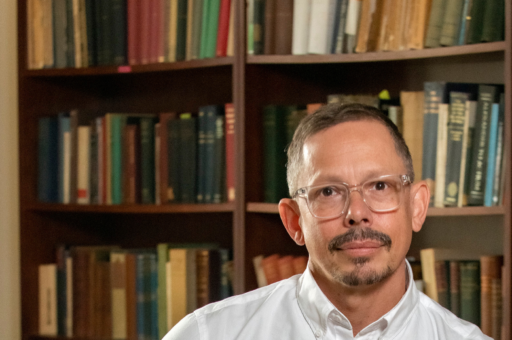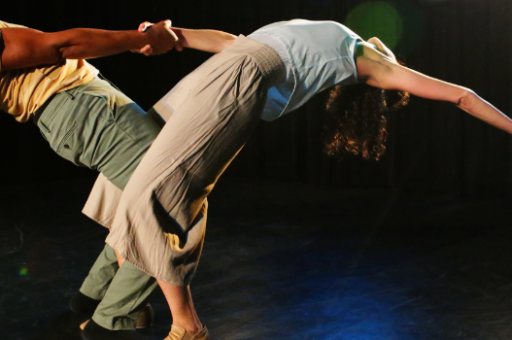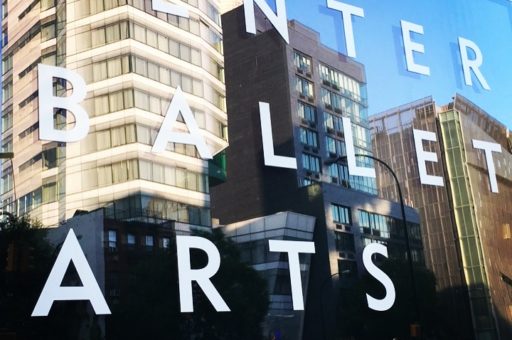Millicent Hodson and Kenneth Archer (CBA ’17) are a dance and design team based in London. For three decades, they have reconstructed lost ballets and created original productions through their partnership entitled Ballets Old & New, staging their work with major companies worldwide. Hodson and Archer give lectures and workshops, write books and articles, and exhibit their production drawings. Their book The Lost Rite, on “Le Sacre du Printemps” (1913), was recently published in Russian by the Vaganova Academy in St Petersburg.
For more about Hodson and Archer’s CBA Fellowship, visit their fellow page.
Please briefly describe your CBA Fellowship project.
Kenneth: Our project is to work on a book entitled Balanchine’s Twenties, which focuses on his five early ballets that we have reconstructed, incorporating material from the interviews we did with his collaborators.
Millicent: The book concerns his ballets in the 1920s when he was in his twenties. We also proposed to teach solos and duets from these reconstructions at dance institutions in the United States as part of the project, and we are about to teach excerpts from Le Chant du Rossignol, Balanchine’s first work for Diaghilev.
You often refer to yourselves as “dance detectives.” What do you mean by that?
K: That title was conferred upon us on the eve of the Joffrey premiere of our reconstructed 1913 Rite of Spring in Los Angeles. The journalist who coined the phrase was Allen Ulrich of the San Francisco Chronicle. (See Appendix A). The title stuck and was picked up by others. After a while we began to use the title too.
M: Once, when we were working at the Paris Opera, the filmmaker of a documentary asked Kenneth, who was inspecting costumes through a magnifying glass, to use the term “Sherlock Holmes.” Robert Joffrey called our work “forensic choreography,” which suggests the same investigative process as “dance detectives.”
CBA brings together multidisciplinary artists and scholars. In certain ways, your work falls into both categories. Could you elaborate?
K: In the course of our professional lives as artists, we both received Ph.D. degrees in our respective fields of art history and dance history. That background prepared us for the intensive international research our work requires. For a reconstruction, we start as scholars researching everything and everywhere for the lost ballet in question. Next, we prepare our design dossiers and choreographic notebooks, working in our London studio. So then we work as both scholars and artists synthesizing it all.
M: Finally, we take the reconstruction to a ballet company and collaborate with every department: the artistic director and administration, the costume and decor ateliers, the dancers and rehearsal staff, the stage technical team, the lighting designer, and the publicity and educational programs. In this period we function as artists, primarily, like any choreographer and designer creating a new work with a company.
What do ballet reconstructions have to offer modern audiences?
K: Reconstructions take years of work, so we choose carefully, being sure that the work chosen is a masterpiece on all levels: music, design, and choreography. In doing so, we turn legends into artifacts. Audiences seem to love the works we have recovered from the early 20th century. As one British critic wrote, “Hodson & Archer put bums on seats.” Companies like that, of course.
M: Our choice does not necessarily mean that at the time of the original work it was regarded as a masterpiece, because some of the greatest repertoire is in advance of its time and not appreciated immediately. It seems that if a work resonates with the two of us, it usually does so with the public as well.
In addition to your seminar, you held several workshops during your time at CBA. how did these inform your work?
K: We did a number of events: teaching The Rite solo at Juilliard, lecturing at Marymount Manhattan College, presenting with the conductor for the film of our reconstructed Jeux at Mark Morris Dance Center, screening a Dutch TV documentary about our reconstruction of Le Chant du Rossignol at The Center, and working with the New York Baroque Dance Company on Nijinsky’s Abandoned Saraband for which we had a private viewing in The Center studio.
M: Each project at each venue reached different dance professionals and students. In the process we reconnected with dancers and writers who have been important to our work and we made many new contacts. At every point we discussed Balanchine’s Twenties and got valuable feedback. Also, we sensed that, perhaps because we were fellows here, people saw the unity of our work together through Ballets Old & New, from Nijinsky to Balanchine.
What tools and resources are most critical when reconstructing a ballet?
K: The most precious resources for a reconstruction are the original collaborators — dancers, composers, conductors, scenarists — and also the second generation, relatives and protegés who sometimes have active memories of a ballet and often have valuable documentation.
M: From the outset of our partnership we realized the clock was ticking on the Ballets Russes and Ballets Suédois. We made the effort to find and interview as many original collaborators as possible. Also, to save time, we decided not to keep writing grant proposals but to immediately reinvest our fees in the next production. So we may not be wealthy but we have a rich repertoire.
K: In regard to tools and techniques for costumes and decors, it was critical to have updated recording devices for interviews, to collect good quality lenses to magnify documents and fabrics, and to gather top quality color keys to recreate the designer’s palette for each reconstruction.
M: Regarding choreography, first and foremost is work in a studio to turn research into movement. But my own process, since my earliest training as a dancer, is also to draw figures in motion. Sometimes I draw to document what I have seen the original dancers do in our interviews or to visualize what we have read in reviews and memoirs of the time. Yet sometimes I draw to discover intuitively links between what we have found and what is still lost.
How has your project evolved during your time at CBA?
K: Discussions about Balanchine’s Twenties during our Fellow Seminar, and during informal conversations after it, have helped us develop a new strategy for how to use our material. We better understand the value of what we have collected and what others would like to read about.
M: The way we present our work as a team for lectures and workshops––Kenneth establishing the larger art historical context and me elaborating the choreography and its significance––is an effective formula for live events. Our interactions at The Center have made us realize this formula can be adapted for our book. This is a major structural breakthrough for a work-in-progress.

“Descent”
Drawing credit: Millicent Hodson
Part of Project by Millicent Hodson and Kenneth Archer with Catherine Turocy: NIJINSKY’S ABANDONED SARABAND
Choreographers: Millicent Hodson and Catherine Turocy
Design Consultant: Kenneth Archer, Ballets Old & New
Notation and Theory Consultants: Claudia Jeschke, dance scholar and Doug Fullington, Audience Education Manager, Pacific Northwest Ballet.
Performers: Catherine Turocy’s New York Baroque Dance Company and guest artists

“Bow”
Drawing credit: Millicent Hodson
Part of Project by Millicent Hodson and Kenneth Archer with Catherine Turocy: NIJINSKY’S ABANDONED SARABAND
Choreographers: Millicent Hodson and Catherine Turocy
Design Consultant: Kenneth Archer, Ballets Old & New
Notation and Theory Consultants: Claudia Jeschke, dance scholar and Doug Fullington, Audience Education Manager, Pacific Northwest Ballet.
Performers: Catherine Turocy’s New York Baroque Dance Company and guest artists




